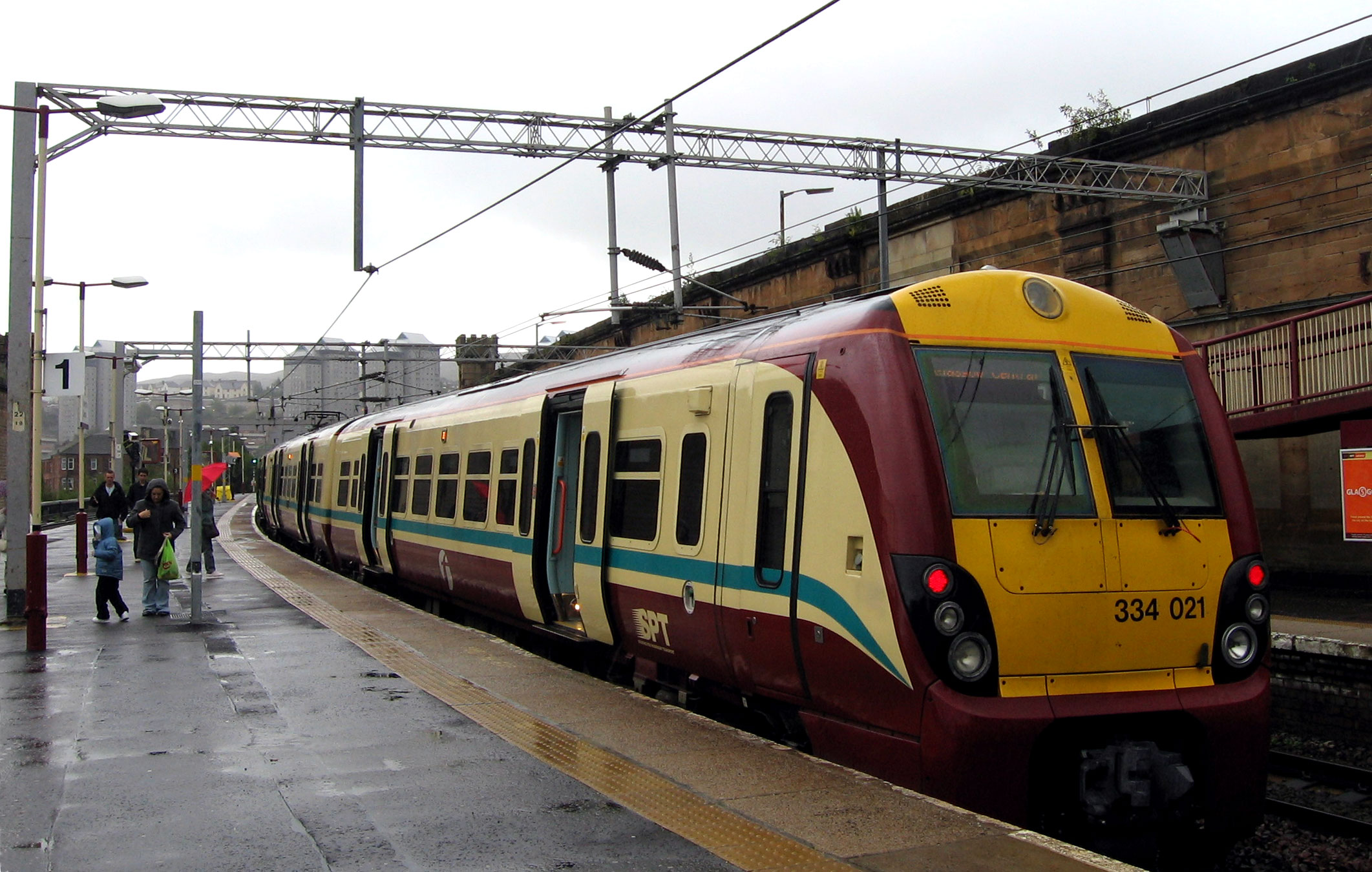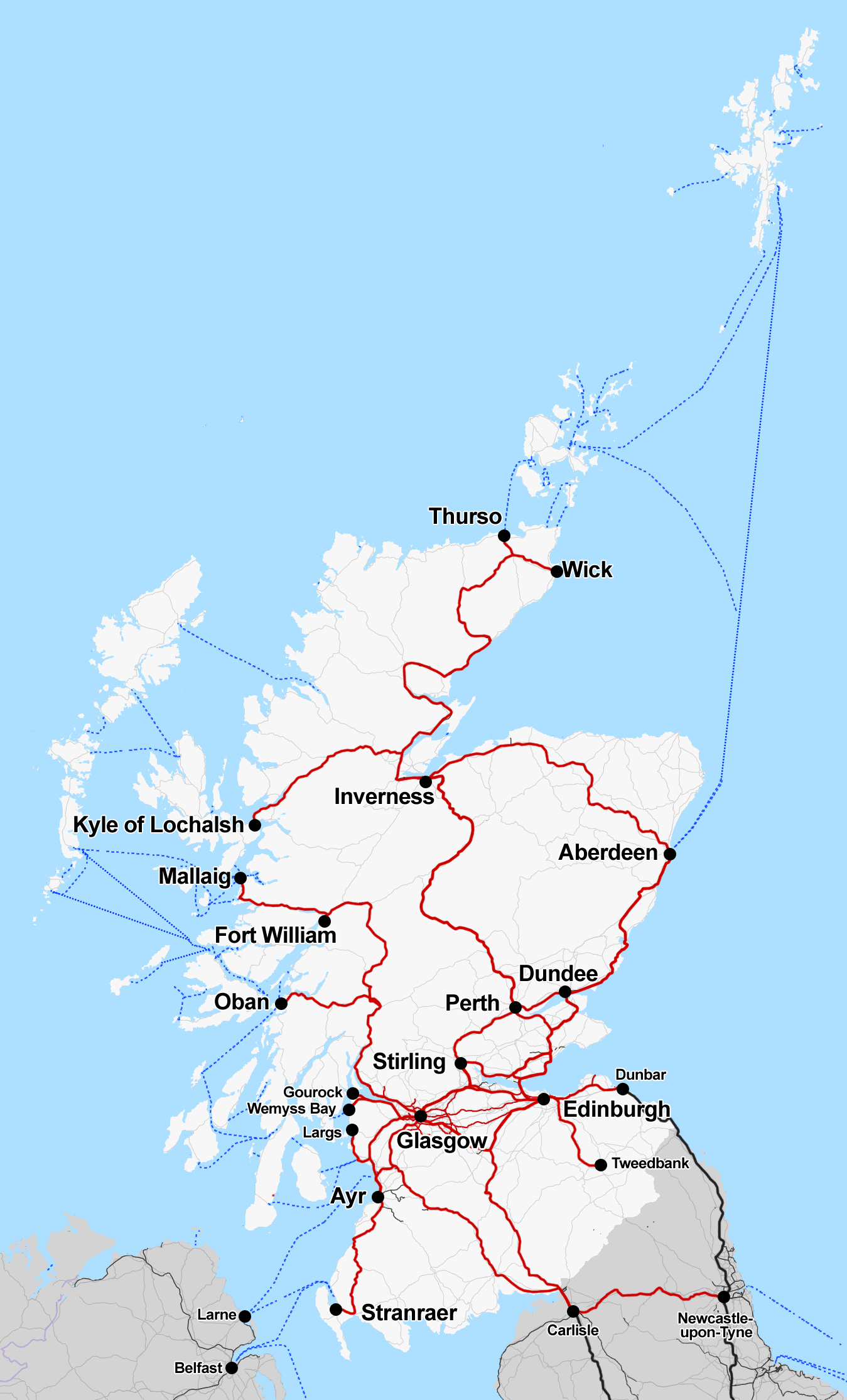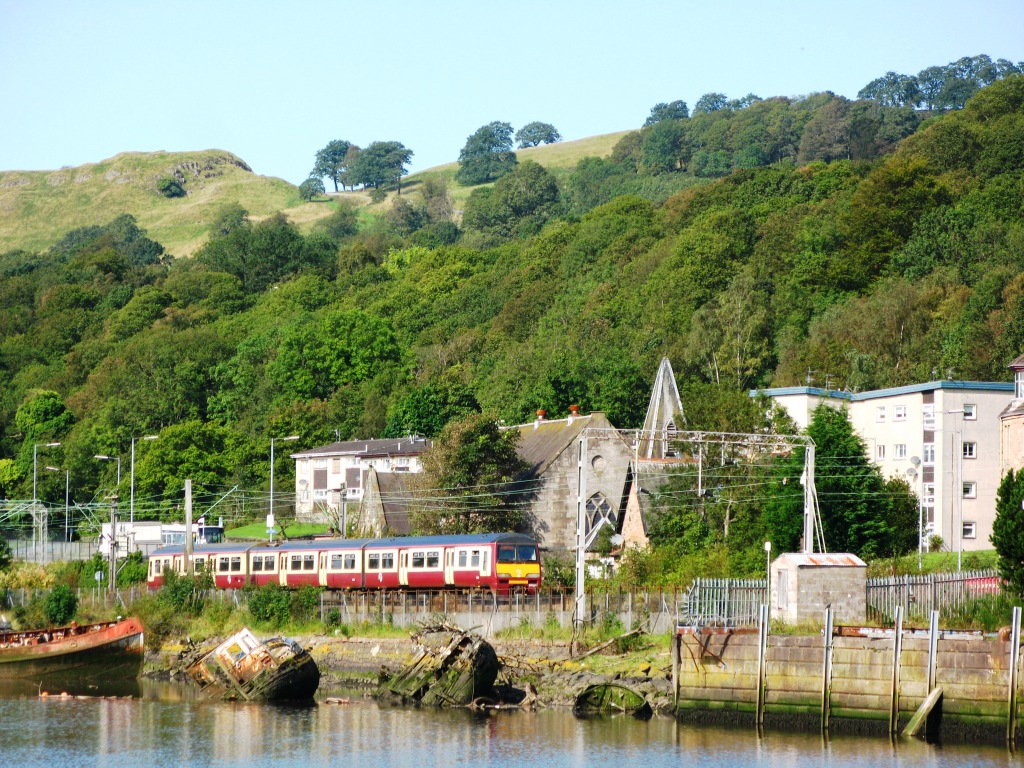|
British Rail Class 334
The British Rail Class 334 is a suburban electric multiple unit passenger train built by Alstom in Birmingham. They are part of Alstom's Coradia Juniper family of trains, along with Classes 458 and 460. The trains are operated by ScotRail and mainly run on the North Clyde Line on - Edinburgh, - and - services. However, they can also sometimes be seen on the Argyle Line on /Milngavie to /// services. They were ordered by SPT/ScotRail (when part of National Express) for outer-suburban services in Glasgow. History Their introduction saw the withdrawal of the last of Glasgow's venerable Class 303 "Blue Train" sets which had been in service since 1960. Although deliveries started to Strathclyde in 1999, the Class 334 did not enter passenger service until 2001 due to numerous teething problems (in common with other Juniper-based classes) and technical failures which plagued the new units upon their introduction. SPT ordered 38 units, but the technical problems led to an ad ... [...More Info...] [...Related Items...] OR: [Wikipedia] [Google] [Baidu] |
ScotRail
ScotRail Trains Limited, trading as ScotRail ( gd, Rèile na h-Alba), is a Scottish train operating company that is publicly owned by Scottish Rail Holdings on behalf of the Scottish Government. It has been operating the ScotRail franchise as an operator of last resort since 1 April 2022. History The ScotRail network had since 2015 been operated by the private-sector franchisee Abellio ScotRail. In December 2019, Transport Scotland announced Abellio had not met the performance criteria necessary to have its seven-year franchise extended for a further three years, and the franchise would conclude on 31 March 2022. In March 2021, Transport Scotland announced that the franchise would not be re-tendered for another private-sector operator to run, but would be operated by an operator of last resort owned by the Scottish Government.ScotRail to be Nationalised ''Rail Express'' issue 300 May 2021 page 6 The move was welcomed by the ASLEF, RMT and TSSA unions. The Minister ... [...More Info...] [...Related Items...] OR: [Wikipedia] [Google] [Baidu] |
Tightlock Coupling
Type H Tightlock couplers are a variety of Janney coupler, typically used on North American mainline passenger rail cars. They are designed with mechanical features which reduce slack in normal operation and prevent telescoping in derailments, yet remain compatible with other Janney types used by North American freight railroads. Like all Janney couplers, the Tightlock is "semi-automatic" with the couplers on cars or locomotives automatically locking when cars are pushed together. However, most tightlock couplers are not fully automatic, as workers still need to go between cars to hook up the air lines for the pneumatic brakes, and connect cables for head-end power and other communications. Also, to separate cars, a worker needs to use a lever to move the locking pin that keeps the coupler closed. In Europe, some operators experimented with making fully automatic tightlock couplers by adding integral pneumatic and electric connectors, but these connections experienced reliabi ... [...More Info...] [...Related Items...] OR: [Wikipedia] [Google] [Baidu] |
Greenock Central 190906b
Greenock (; sco, Greenock; gd, Grianaig, ) is a town and administrative centre in the Inverclyde council area in Scotland, United Kingdom and a former burgh within the historic county of Renfrewshire, located in the west central Lowlands of Scotland. It forms part of a contiguous urban area with Gourock to the west and Port Glasgow to the east. The 2011 UK Census showed that Greenock had a population of 44,248, a decrease from the 46,861 recorded in the 2001 UK Census. It lies on the south bank of the Clyde at the "Tail of the Bank" where the River Clyde deepens into the Firth of Clyde. History Name Place-name scholar William J. Watson wrote that "Greenock is well known in Gaelic as Grianáig, dative of grianág, a sunny knoll". The Scottish Gaelic place-name ''Grianaig'' is relatively common, with another (Greenock) near Callander in Menteith (formerly in Perthshire) and yet another at Muirkirk in Kyle, now in East Ayrshire. R. M. Smith in (1921) described the alterna ... [...More Info...] [...Related Items...] OR: [Wikipedia] [Google] [Baidu] |
Glasgow
Glasgow ( ; sco, Glesca or ; gd, Glaschu ) is the most populous city in Scotland and the fourth-most populous city in the United Kingdom, as well as being the 27th largest city by population in Europe. In 2020, it had an estimated population of 635,640. Straddling the border between historic Lanarkshire and Renfrewshire, the city now forms the Glasgow City Council area, one of the 32 council areas of Scotland, and is governed by Glasgow City Council. It is situated on the River Clyde in the country's West Central Lowlands. Glasgow has the largest economy in Scotland and the third-highest GDP per capita of any city in the UK. Glasgow's major cultural institutions – the Burrell Collection, Kelvingrove Art Gallery and Museum, the Royal Conservatoire of Scotland, the Royal Scottish National Orchestra, Scottish Ballet and Scottish Opera – enjoy international reputations. The city was the European Capital of Culture in 1990 and is notable for its architecture, cult ... [...More Info...] [...Related Items...] OR: [Wikipedia] [Google] [Baidu] |
National Express
National Express Group is a British multinational public transport company headquartered in Birmingham, England. It operates bus, coach, train and tram services in the United Kingdom, Ireland (National Express operates Eurolines in conjunction with Bus Éireann), United States, Canada, Spain, Portugal, Malta, Germany, Bahrain, and Morocco and long-distance coach services across Europe. It is listed on the London Stock Exchange and is a constituent of the FTSE 250 Index. History In 1972, the state-owned National Bus Company decided to bring together the scheduled coach services operated by its bus operating companies in the United Kingdom under one brand. Sir Frederick Wood, a prominent businessman and industrialist, was asked to oversee the creation of this new business model and led the group as its chairman from 1972 to 1978. Initially branded as ''National'', the ''National Express'' brand was first used in 1974.Tram and V/Line Passenger rail franchises in the Australia ... [...More Info...] [...Related Items...] OR: [Wikipedia] [Google] [Baidu] |
ScotRail (National Express)
ScotRail was a train operating company in Scotland owned by National Express that operated the ScotRail franchise from March 1997 until October 2004. Prior to March 1997 ScotRail (British Rail) ran the trains and after October 2004 First ScotRail ran them. Services ScotRail operated all passenger train services in Scotland, with the exception of the Arriva Trains Northern, GNER, Virgin CrossCountry and Virgin Trains West Coast services from England. ScotRail operated services into England with services to Carlisle and Newcastle, and the Caledonian Sleeper services between Scotland and London. Rolling stock ScotRail inherited a fleet of Class 101, Class 117 Class 150, Class 156, Class 158, Class 303, Class 305, Class 314, Class 318 and Class 320s from British Rail as well as Mark 2 carriages and Mark 3 sleepers for use on the Caledonian Sleepers and on some other passenger services. ScotRail contracted English Welsh & Scottish to haul the Caledonian Sleeper servi ... [...More Info...] [...Related Items...] OR: [Wikipedia] [Google] [Baidu] |
Strathclyde Partnership For Transport
Strathclyde Partnership for Transport (SPT) is a regional transport partnership for the Strathclyde area of western Scotland. It is responsible for planning and coordinating regional transport, especially the public transport system in the area, including responsibility for operating the Glasgow Subway, the third oldest in the world. History The principal predecessor to SPT was the Greater Glasgow Passenger Transport Executive (GGPTE) set up in 1972 to take over the Glasgow Corporation's public transport functions and to co-ordinate public transport in the Clyde Valley. In the 1980s it was replaced by the Strathclyde Passenger Transport Executive (SPTE), under the overall direction of Strathclyde Regional Council. Section 40 of the Local Government etc. (Scotland) Act 1994 created a new ''statutory corporation'', the Strathclyde Passenger Transport Authority (SPTA), which took over "''all of the functions, staff, property, rights, liabilities and obligations of Strathclyd ... [...More Info...] [...Related Items...] OR: [Wikipedia] [Google] [Baidu] |
Argyle Line
The Argyle Line is a suburban railway located in West Central Scotland. The line serves the commercial and shopping districts of Glasgow's central area, and connects towns from West Dunbartonshire to South Lanarkshire. Named for Glasgow's Argyle Street, the line uses the earlier cut-and-cover tunnel running beneath that thoroughfare. The term "Argyle Line" is commonly used to describe: * the extensive urban passenger train service that connects the towns and suburbs of North Clyde with Motherwell, Larkhall, and Lanark, to the southeast. Of the 48 stations, 4 are in West Dunbartonshire, 4 in East Dunbartonshire, 17 in Glasgow City, 10 in North Lanarkshire, and 13 in South Lanarkshire. * the central portion of railway infrastructure encompassing less than . History Prior to 1964 The Glasgow Central Railway (GCR) under central Glasgow opened in 1886, connecting the Lanarkshire and Dunbartonshire Railway at and Stobcross Railway at to the Lanarkshire and Ayrshire Railway near ... [...More Info...] [...Related Items...] OR: [Wikipedia] [Google] [Baidu] |
Edinburgh Waverley Railway Station
Edinburgh Waverley railway station (also known simply as Waverley; gd, Waverley Dhùn Èideann) is the principal railway station serving Edinburgh, Scotland. It is the second busiest station in Scotland, after Glasgow Central. It is the northern terminus of the East Coast Main Line, from , although some trains operated by London North Eastern Railway continue to other Scottish destinations beyond Edinburgh. Location Waverley station is situated in a steep, narrow valley between the medieval Old Town and the 18th century New Town. Princes Street, the premier shopping street, runs close to its north side. The valley is bridged by the North Bridge, rebuilt in 1897 as a three-span iron and steel bridge, on huge sandstone piers. This passes high above the station's central section, with the greater half of the station being west of North Bridge. The central booking hall is just west of the northern massive stone pier of the bridge and cleverly hides it within its bulk. ... [...More Info...] [...Related Items...] OR: [Wikipedia] [Google] [Baidu] |
North Clyde Line
The North Clyde Line (defined by Network Rail as the ''Glasgow North Electric Suburban'' line) is a suburban railway in West Central Scotland. The route is operated by ScotRail Trains. As a result of the incorporation of the Airdrie–Bathgate rail link and the Edinburgh–Bathgate line, this route has become the fourth rail link between Glasgow and Edinburgh. Route The North Clyde Line (known as Dunbartonshire - Glasgow, Cumbernauld and Falkirk Grahamston in timetables), electrified by British Rail in 1960, ran east–west through the Greater Glasgow conurbation, linking northern Lanarkshire with western Dunbartonshire, by way of the city centre. Fifty years later, in 2010, the line was extended by Network Rail east from Airdrie, by way of re-opening the line to Bathgate meeting up with the line re-opened by British Rail from Edinburgh. The main core of the route runs from to via and Glasgow Queen Street (Low Level). To the east of the Glasgow city centre, there ... [...More Info...] [...Related Items...] OR: [Wikipedia] [Google] [Baidu] |
British Rail Class 460
The British Rail Class 460 ( 8-GAT) was a class of electric multiple-unit passenger trains built by Alstom at Washwood Heath between 1999 and 2001. They were part of Alstom's Juniper family, which also includes Classes and . For the entirety of their service life they operated Gatwick Express services between London Victoria and Gatwick Airport. Following their withdrawal by Gatwick Express in 2012, the fleet was merged with the mechanically similar Class 458 fleet and extensively rebuilt to form a fleet of 36 units—designated Class 458/5—that are now used by South Western Railway. History National Express (NX) began operating the Gatwick Express franchise in April 1996, having been awarded a 15-year contract to do so by the Director of Passenger Rail Franchising as part of the privatisation of British Rail. The company was required as part of the award to replace the existing Gatwick Express rolling stock, which had already been in service for more than 12 years when ... [...More Info...] [...Related Items...] OR: [Wikipedia] [Google] [Baidu] |
British Rail Class 458
The British Rail Class 458 ( 5-JUP) is a class of electric multiple unit passenger trains built by Alstom at Washwood Heath between 1998 and 2002 for South West Trains. They were the first new fleet of trains to be delivered following the privatisation of British Rail. The order for the original fleet of 30 four-car trains was placed in 1997, and delivery of the first unit followed in October 1998. The fleet entered passenger service between 2000 and 2003 and is maintained at Wimbledon depot. They are part of Alstom's ''Coradia Juniper'' family of trains, which also includes Classes and . Between 2013 and 2016, the class was merged with the mechanically similar Class 460 fleet and extensively rebuilt to form a fleet of 36 five-car units—designated Class 458/5—to provide an increase in capacity on services into . The trains are now used by South Western Railway. In March 2021 South Western Railway announced that 28 Class 458 units would be refurbished and redeploye ... [...More Info...] [...Related Items...] OR: [Wikipedia] [Google] [Baidu] |







_04_(6390134977)_adjusted.jpg)
8021_(6336760961).jpg)